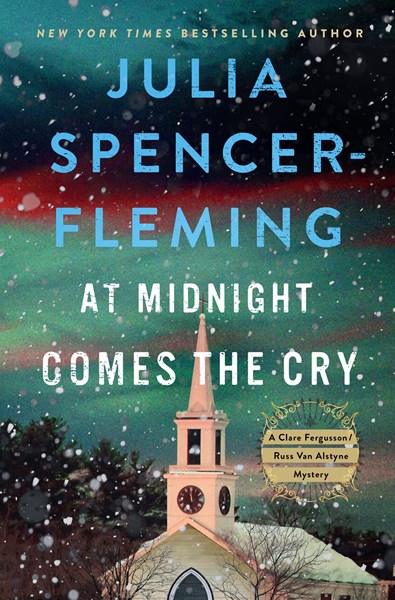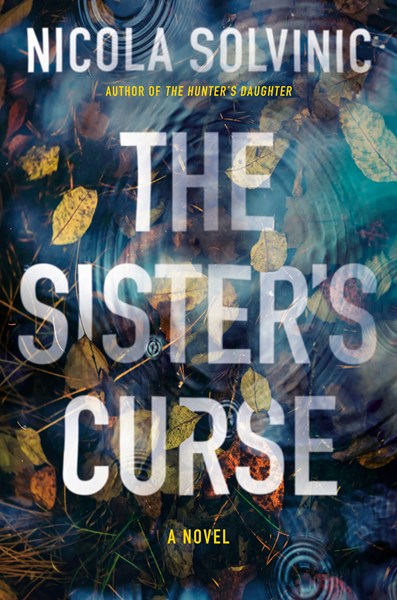Clare Fergusson and Russ Van Alstyne are now married and happy despite the innate differences of an ex-pilot Episcopal priest and a now-retired police chief. Son Ethan, eight months old, has a stay-at-home dad as a caregiver and things are relatively smooth until the annual Thanksgiving day parade is beset by white supremacists. Officer Knox, newest on the Miller’s Kill police department, is concerned about the disappearance of Syracuse PD officer Kevin Flynn, who was assigned to a state task force to infiltrate the sort of group that disrupted the parade. When Russ and Knox search the woods, two interesting new characters join their quest: Yixin Zhao, from the state attorney’s office; and Paul Terrance, from the park service. Clare is not left out, having taken on the task of saving an abused young mother whose husband is part of a supremacist group, and her child. With great outdoor scenes, tight plotting, and appealing characters, this will hold readers’ attention and leave them hungry for more.
Police Procedural
Life in a small town in Minnesota is not supposed to involve complex crimes in the middle of a heat wave, at least that’s how Sheriff Red Hammergren feels, but when missing public-health nurse Joanie Crea’s body is found on the run-down estate of the formerly wealthy Grandgeorge family, tensions and suspicions run away with the locals. There is little help coming from Joanie’s rigid, bureaucratic robot of a boss or her glad-handing, church deacon of a husband. The body of a second woman is found and information from her abused and recently beaten young son may hold a key. A mystery man with a green jacket, missing funds, and long-held secrets all play with Red’s sixth sense, making her feel that the solution is just beyond her grasp. Help comes from Red’s poker-playing buddies and Waltz, a crime scene tech, but her indomitable need to solve the crime is primary. This is a deeply atmospheric and compelling read. We can only hope for more from the series.
Beautiful, upstate New York, small town Cape Vincent is a place where everybody knows one another. When famous retired hockey player Mikko Helle buys a waterfront house and completely renovates it, he hires Nicole Durham, a local woman, to clean before he moves in. She finds a young woman secretly living inside the house, then the police investigate and discover the remains of another young woman in the basement. With a string of bizarre thefts of items that seem to have no value, the squatter in Helle’s house appears to be the perfect suspect for both the break-ins and the murder. Suspicions mount and trust disappears when Nicole learns about her husband’s surprising connection to the unexpected house guest, the dead body, and Helle’s secret business dealings. How do you discover the truth when everything is built on lies? Wegert creates a vivid town and realistic inhabitants with this taut and compelling mystery. Comparisons to Gillian Flynn’s Sharp Objects and books by Jane Harper and Lucy Foley are warranted
While this is the 11th in a long-running series, readers can ignore all the threads of the ongoing story and only attend to the current bizarreness of a birdwatching tour occurring in wintry Nebraska, and immediate family drama. Kate Fox is preparing for an incoming blizzard when the sheriff calls to tell her that a van of birdwatchers has run off the road and needs rescuing. All local first responders are otherwise occupied, so Kate, sister Louise, and friend Deenie marshal forces in true midwestern fashion and take the stranded group to the local high school to ride out the storm. Louise, a miracle worker of sorts, arrives with enough food, equipment, and know-how to feed and provide beds for the group, though perhaps not to the visitors’ snobby standards. This is a record storm, and they are truly stuck, but however prepared they are, murder is not something that is expected. With homage to Agatha Christie and old-fashioned library books, the ordeal is survived, and the crime is solved in this oddly retro and engaging locked-room mystery.
In a quiet Ontario town, days after Christmas, Evelyn Massey, over 90 years old, is found dead in her home with a note guiding Alice, a local policewoman, to a dead body buried in the basement for more than 60 years. More bodies are found, all from the same time period, with evidence suggesting Evelyn’s long dead husband as the guilty party. He is considered saintly by his daughters and granddaughter and the family friends still living, most of whom are also in their 90s, making this no easy case to investigate. Assisting Alice’s able and interesting team is Hugh Mercer, late of the NYPD, in the area doing a sort of personal penance for his career. The local chief goes so far as to suggest letting the mystery of the dead bodies slide since it all happened long ago and everyone is so old, but the serial killer emerges in a dramatic fashion, bringing all the motives to the open, including Alice’s private demons. The weather and landscape play an integral part in this somewhat bleak story that’s best read on a sunny day.
Stewart brings us back to a time of tumult: mid-1960s rural Vermont. In this sequel to Agony Hill, we are reintroduced to Detective Frank Warren, a good guy whose efforts at law enforcement—assisted by Trooper “Pinky” Goodrichsend—see the two of them traipsing up and down the county at all hours. This book opens as one of the visitors to the Ridge Club, a hunting and fishing lodge exclusively for rich and distinguished men, is found dead, on the same day that deer season opens. A mere coincidence, right? But Frank suspects that there may be more than someone accidentally shooting themselves while cleaning their rifle. So he and Pinky launch an investigation that tangles them up in the Ridge Club members when a violent snowstorm comes along to isolate them even further. This closed-circle narrative is wonderfully well-done, deeply satisfying, and a compelling portrait of a community undergoing change. Readers who enjoy these books will also appreciate Julia Spencer-Fleming, William Kent Krueger, and Ausma Zehanat Khan.
In Solvinic’s debut, The Hunter’s Daughter, readers met Detective Anna Koray, daughter of a forest-god worshipping serial killer, who was in therapy to bring back childhood memories (this latest book can stand alone, but it’s worth going back to the first to get to know Anna better). She’s still an expert at her father’s curriculum—wilderness tracking—a skill that comes into play when there is new upheaval in the area, starting with the near-drowning of a boy who’s rescued by Anna. She suspects that the almost-tragic event may not have been an accident, and the investigation brings in the long-cold crime of a local woman who disappeared 25 years before and wrongdoings of the town’s rich thugs, all tinged with supernatural elements. In the meantime, Anna’s continuing her relationship with a young, devoted ER doctor who has problems of his own. Anna is a complex character with a well-hidden dark side that, combined with her steadfast kindness and smarts, will keep readers rooting for her to come out on top. For fans of wilderness thrillers and all who enjoy a thrilling police procedural.
Chase Burke works as a sommelier for a restaurant in New York’s Chrysler Building and has put his military life behind him. He’s about to ask out a pretty government official, Tanya, who is visiting him on the job, when armed men attack, and she seems to be their target. Chase kills some of the men, but Tanya is hurt. Detective James Campbell and his partner, Detective Alice Doyle, are assigned the case and are told to work closely with Federal authorities. They soon determine that Chase has a lot of skeletons in his closet, and he immediately becomes the prime suspect. Chase realizes he must uncover the truth if he’s not going to rot in jail for the rest of his life, but digging for answers puts him in the crosshairs of a secret group of killers that thinks he knows too much. Whom can he trust while his face is plastered all over every news channel? From the opening page to the last, this book is a relentless force of non-stop action and thrills. Gervais and Steck write great books and have crafted a stellar story together. Comparisons to Mark Greaney and Jack Carr are warranted, but this first in a series might be even better. The next one cannot come fast enough.
Kipness compellingly combines her background as a sports reporter with her love of crime fiction, and her latest Kate Green thriller is her best yet. Kate is a sports reporter with a recent Emmy win, and she’s asked to cover the U.S. Open and specifically to interview two tennis stars: Brynn, an arrogant but talented up-and-comer, and Lucy, a veteran facing her last event. Brynn does not trust Kate at all, while Lucy is nicer but also hesitant. As Kate continues her coverage, she begins to uncover details that seem straight out of a soap opera rather than the tennis circuit. When Lucy forfeits a match the day after Kate interviews her, the reporter knows that something happened to Lucy and then receives a photo of the bound and gagged player. Kate can’t help but investigate, an effort that will uncover secrets about Lucy and Brynn and reveal personal elements of Kate’s life. There are many suspects here and it is so much fun from the first page to the last. Kipness’s engaging novel is perfect for newcomers to and fans of the series and is a blend of Hank Phillippi Ryan’s work and the Myron Bolitar novels by Harlan Coben. With a recently announced TV deal with Universal Television, picking this up should not be a close call.
A homeless man is discovered dead in Bristol’s park-like Clifton Downs. End of the story, right? Not if you are DS Cross, who “was always drawn to cases like this. Cases of the dispossessed. The outsider. He related to them because in many ways he was one himself.” Cross has Asperger’s syndrome, and unlike his peers, he is slow to write off the victim. Indeed, his persistence, his dogged examination of all the details, and his reexamination of the evidence manage to keep the case alive—traits that serve the victim but set his fellow officers on edge, ready to wrap up the case. Say what they want, Cross has the best conviction rate of his precinct by a long shot. In seeking to resolve the murder of the homeless man, Cross realizes he needs to go back to a cold case from 15 years ago, despite the scorn he receives from his boss and peers. Socially awkward detectives are nothing new, but Sullivan goes deep into Cross’s self and his struggle to identify the personalities of others: he combines physical expressions with tone to make inferences. The publishing history of this series is extraordinarily confusing, but we know for certain that Grove is publishing the first three books in the series, as well as The Tailor, the eighth, in October. Order multiple copies, there should be a big audience for Cross, both those with Aspergers who rarely see themselves depicted with any accuracy and fans of police dramas like Tana French, Donna Leon, and Louise Penny.










